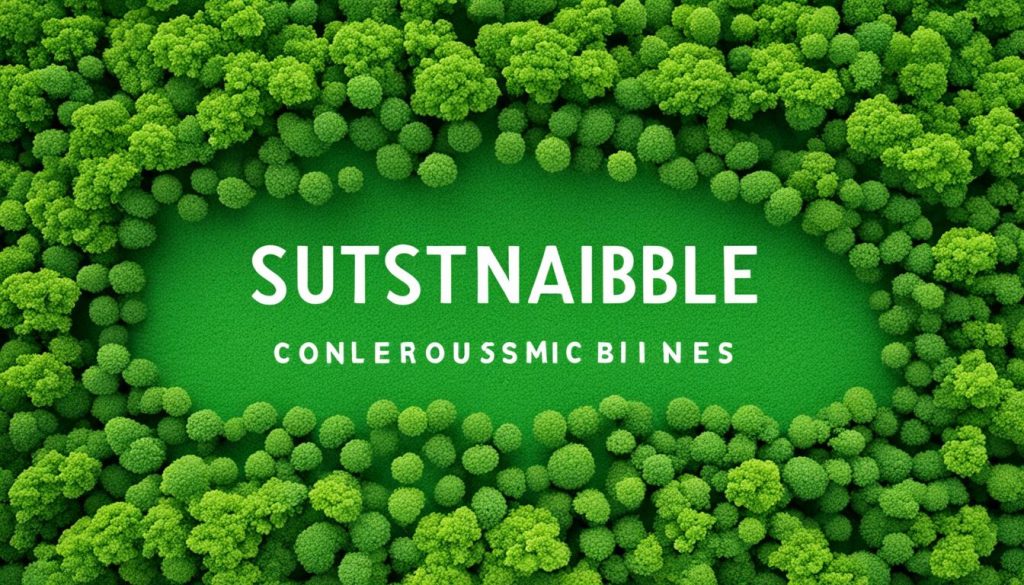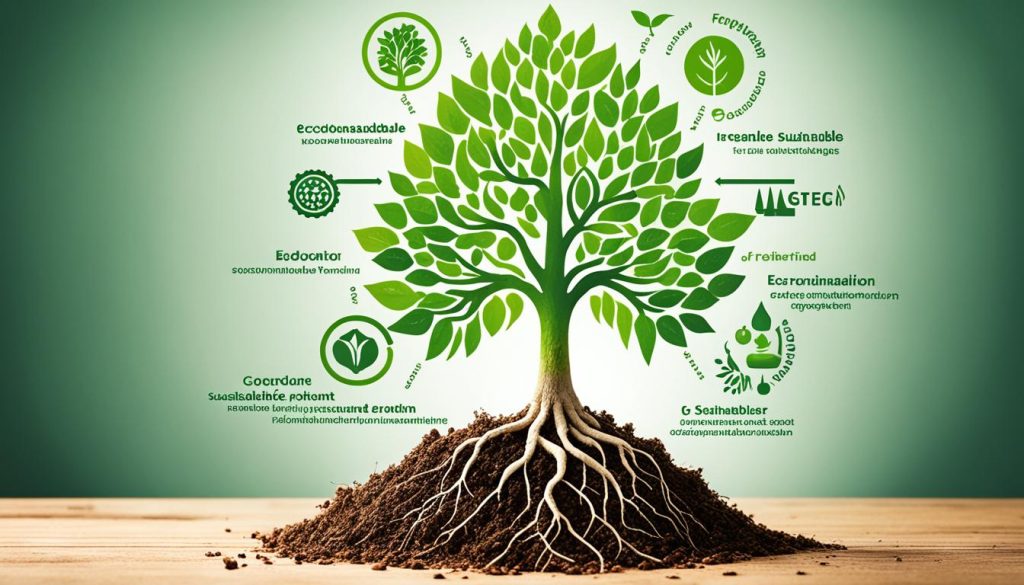Welcome to the world of sustainable product development, where eco-friendly design and green manufacturing processes take center stage. In an era of growing environmental consciousness, businesses are realizing the importance of incorporating sustainability principles into every step of the product development journey. From environmental product innovation to ethical product creation, companies are embracing sustainable supply chain management and sustainable materials sourcing to create products that have a minimal impact on the planet’s resources.
Sustainable product development goes beyond just making green products – it encompasses the entire product lifecycle. From concept to end-of-life disposal, companies are reevaluating their strategies to ensure that sustainability is at the forefront. By considering the environmental and social factors during the design phase, businesses can mitigate risks, seize new opportunities, and pave the way for sustainable growth.
To embark on this sustainable journey, companies need to evaluate their current sustainability efforts and address three foundational capabilities. The first is leadership awareness and strategy, where top-level executives gain a deep understanding of the importance of sustainability and set a clear vision for the organization. The second is the establishment of sustainability policies and guidelines, providing a framework for sustainable decision-making and action. The third is measuring sustainability impact, allowing companies to track progress, identify areas for improvement, and communicate their sustainability achievements.
Key Takeaways:
- Embrace eco-friendly product design and green manufacturing processes
- Consider environmental and social factors throughout the entire product lifecycle
- Evaluate and enhance leadership awareness and strategy for sustainable product development
- Establish sustainability policies and guidelines
- Measure and communicate sustainability impact
The Financial Impact of Sustainability
Moderate or severe sustainability events can have a significant financial impact on companies, often resulting in stock market losses. In fact, studies have shown that these events can cause stock prices to drop by up to 7.5% within a 12-month period.
One of the key factors contributing to these losses is the failure of companies to consider sustainability throughout the product development life cycle. Ignoring sustainability risks can lead to unforeseen financial consequences as consumers and investors increasingly prioritize environmentally responsible practices.
To minimize these risks, it is crucial for businesses to thoroughly review their product ideas and development life cycles. By integrating sustainability factors into every stage of product development, companies can identify and address potential environmental, social, and economic risks before they escalate.
By addressing sustainability early in the product development process, companies can mitigate financial losses and capitalize on the growing demand for sustainable products.
“Sustainability risks are no longer just ethical concerns; they have direct financial implications. Companies that fail to recognize this reality may find themselves facing significant economic setbacks.”
The Need for Sustainable Risk Assessment
Integrating sustainability into the product development life cycle requires a comprehensive approach that considers the environmental, social, and economic impacts of a product. By conducting thorough risk assessments, companies can identify potential sustainability challenges and implement strategies to address them.
Here are key steps businesses can take to assess and mitigate sustainability risks:
- Evaluate the environmental impact of sourcing materials and production processes.
- Consider the social implications of the product’s lifecycle, including labor practices and community engagement.
- Analyze the financial risks associated with potential environmental regulations and market trends.
- Investigate the product’s potential for waste reduction and circularity, contributing to long-term sustainability.
- Engage stakeholders, including customers, suppliers, and investors, to gather insights and align sustainability goals.
By proactively addressing sustainability factors and conducting rigorous risk assessments, companies can safeguard their financial stability and position themselves as leaders in the rapidly evolving sustainable market.
Real-World Examples
Several companies have experienced the financial impact of sustainability events and have taken swift action to address the risks. For example:
- Company XYZ, a leading consumer goods brand, suffered a significant stock market loss after a sustainability event revealed unethical sourcing practices. The company’s stock price dropped by 5% within a month.
- Company ABC, a renewable energy provider, experienced a surge in market value following a successful sustainability initiative. By demonstrating a commitment to clean energy production, the company attracted investors and saw a 10% increase in its stock price.
- Company DEF, an automobile manufacturer, faced a decline in sales and stock prices when sustainability concerns arose regarding the environmental impact of their manufacturing processes. As a result, the company implemented a comprehensive sustainability plan and saw a gradual recovery of its stock.
These examples illustrate the importance of incorporating sustainability throughout the product development life cycle and the potential financial consequences of overlooking sustainability factors.
Current Sustainability Efforts
Many companies are actively engaged in sustainability enhancements to their existing products. While these efforts are well-intentioned, they often come with unintended consequences in terms of environmental and social costs. In addition, they may not result in a fully sustainable offering. To achieve true sustainability, businesses need to take a holistic approach that encompasses not only product enhancements but also considerations such as packaging, resource utilization, and waste reduction.
The key to successful sustainability is embedding the ethos of sustainability into every stage of product development, from ideation to design and production. By incorporating sustainability objectives from the outset, companies can minimize wasted resources and mitigate environmental impacts. It is essential to align sustainability efforts with overarching corporate sustainability goals to ensure consistency and long-term impact.
“To achieve true sustainability, businesses need to take a holistic approach.”
Packaging plays a significant role in sustainability efforts. Companies should evaluate their packaging choices to minimize material usage, incorporate recycled or renewable materials, and optimize for recyclability or biodegradability. Sustainable packaging not only reduces the environmental footprint but also conveys a brand’s commitment to sustainability to consumers.
Environmental and Social Costs
When companies focus solely on implementing sustainability enhancements without a comprehensive strategy, there can be unintended negative consequences. These may include:
- Increased environmental impact due to inefficient use of resources
- Unaddressed social costs, such as labor rights violations or unsafe working conditions in the supply chain
- Wasted resources and inefficiencies in production processes
By considering the full product life cycle and addressing these issues upfront, companies can better achieve their sustainability objectives while minimizing adverse effects.
Sustainability Enhancement Table
| Sustainability Enhancements | Impact |
|---|---|
| Improving energy efficiency | Reduces carbon emissions and energy consumption |
| Reducing packaging waste | Minimizes environmental impact and improves recycling rates |
| Transitioning to sustainable materials | Preserves natural resources and reduces reliance on non-renewable materials |
| Optimizing supply chain logistics | Reduces transportation-related carbon emissions and improves efficiency |
The table above highlights some common sustainability enhancements and their respective impacts. While these efforts contribute positively to sustainability, it is crucial to consider their broader implications and align them with comprehensive sustainability strategies.
Foundational Capabilities for Sustainability Integration
Integrating sustainability into product development requires foundational capabilities that many companies currently lack. These capabilities include leadership awareness, a clear strategy for product sustainability, well-defined sustainability policies and guidelines, and reliable means of measuring sustainability impact.
Leadership awareness is essential for driving sustainable practices throughout the organization. Without leadership buy-in and a shared vision of the importance of sustainability, it can be challenging to enact meaningful change. Company leaders must champion sustainability and prioritize it as a core value within the organization.
A clear strategy for product sustainability is crucial for guiding decision-making across the product development process. It sets the direction for integrating sustainability principles, ensuring that sustainable practices are embedded from the initial design stages to the final product release. This strategy should align with the company’s overall sustainability vision and objectives.
Well-defined sustainability policies and guidelines provide a framework for incorporating sustainable practices into product development. These guidelines outline design principles, manufacturing processes, and material sourcing criteria that promote environmental and social responsibility. They serve as a reference for the development team and ensure consistent adherence to sustainability standards.
Measuring the sustainability impact of products is vital for evaluating and improving their environmental and social performance. Companies need reliable metrics and measurement tools to assess the sustainability outcomes of their products, from resource consumption to carbon emissions and social impacts. This data allows for informed decision-making and the identification of areas for improvement.
Companies that have these foundational capabilities in place are better equipped to integrate sustainability into their product development processes effectively. They can create products that have a positive impact on both the environment and society, while also meeting customer expectations and business goals.
Leadership Awareness: Inspiring Sustainable Change
Leadership awareness plays a significant role in driving sustainable practices within organizations. When leaders recognize the importance of sustainability and actively promote it, employees are more likely to embrace and prioritize sustainable product development. Leadership support can enable the allocation of resources, encourage collaboration, and foster a culture that values sustainability.
Clear Strategy for Product Sustainability: Guiding Sustainable Decision-Making
A well-defined strategy for product sustainability sets the direction for integrating sustainability into the entire product development life cycle. It outlines goals, targets, and specific actions to embed sustainable practices into design, manufacturing, and distribution processes. This strategy acts as a roadmap, guiding decision-making and ensuring that sustainability is considered at every stage of development.
Design and Development Guidelines: Incorporating Sustainable Principles
Design and development guidelines provide a framework for incorporating sustainable principles into product creation. These guidelines outline sustainable design strategies, material sourcing criteria, and manufacturing processes that minimize environmental impact. They help designers and engineers make informed decisions that prioritize sustainability without compromising product performance or quality.
Measuring Sustainability Impact: Tracking Environmental and Social Performance
Measuring the sustainability impact of products is crucial for monitoring and improving their environmental and social performance. By collecting data on resource consumption, carbon emissions, waste generation, and social impacts, companies can identify areas for improvement and set targets for reducing their environmental footprint. This measurement also allows for transparency and accountability, enabling companies to communicate their sustainability achievements to stakeholders.
Developing these foundational capabilities is essential for integrating sustainability into product development processes effectively. Companies that prioritize leadership awareness, sustainability vision, design and development guidelines, and measuring sustainability impact are better positioned to create products that align with the principles of environmental and social responsibility.
Recommendations for Sustainability in the Product Development Life Cycle
Embedding sustainability in product development requires key decision-making across strategy, portfolio, and product tiers. To effectively integrate sustainability into the product development life cycle, businesses should consider the following recommendations:
1. Product Innovation
Product innovation plays a critical role in achieving enterprise-level sustainability objectives. Companies should prioritize sustainable product ideas and consider how each innovation contributes to broader sustainability goals.
2. Portfolio Mix for Sustainability Investments
Assessing the portfolio mix for sustainability investments allows companies to allocate resources strategically. By prioritizing sustainable projects and initiatives, businesses can drive long-term sustainability improvements across their product offerings.
3. Product Development Methodology
Incorporating sustainability parameters into the product development methodology ensures that sustainability considerations are integrated into every stage of the process. Companies should establish clear guidelines and practices that promote sustainability and align with their sustainability objectives.
By implementing these recommendations, businesses can create a more sustainable product development process that leads to environmental and social benefits.
| Product Innovation | Portfolio Mix for Sustainability Investments | Product Development Methodology |
|---|---|---|
| Emphasize sustainable product ideas | Allocate resources strategically | Incorporate sustainability parameters |
| Contribute to enterprise-level sustainability | Drive long-term sustainability improvements | Ensure sustainability considerations at every stage |
Companies should evaluate their current sustainability efforts and address three foundational capabilities: leadership awareness and strategy, sustainability policies and guidelines, and measuring sustainability impact.
By focusing on sustainable product innovation, optimizing the portfolio mix for sustainability investments, and implementing a robust product development methodology, businesses can drive positive environmental and social change while achieving their enterprise-level sustainability objectives.
Sustainability Innovation in Action
Several companies have embraced sustainable product innovation to drive positive change in their industries. These forward-thinking organizations have implemented strategies that prioritize sustainability throughout their operations. Let’s take a look at a few examples:
1. Medical Device Company
A leading medical device company has made sustainable design a core component of its business practices. From sourcing raw materials responsibly to utilizing eco-friendly packaging, the company is committed to reducing its environmental impact. Additionally, they have implemented sustainable manufacturing processes and waste management solutions to ensure a sustainable product lifecycle.
2. Packaged Foods and Beverage Manufacturer
A prominent packaged foods and beverage manufacturer understands the importance of sustainability in the food industry. They have incorporated sustainability and social factors into their innovation funnel prioritization. By considering environmental and social aspects during the ideation and development stages, they are able to create products that meet consumer demand while minimizing their environmental footprint.
3. Industrial Product Manufacturer
An industrial product manufacturer has taken significant steps to reduce its environmental impact. They actively collaborate with clean-up campaigns and environmental organizations to address plastic pollution and emissions. Through innovative design changes and investment in sustainable practices, they aim to minimize plastic usage and reduce emissions throughout their supply chain.
These real-life examples demonstrate that sustainable product innovation can be achieved across various industries. By integrating sustainable principles into their operations, these companies not only contribute to environmental preservation but also establish themselves as industry leaders in sustainability.
Continue reading to learn more about the benefits and challenges of sustainable product development.
| Company | Sustainable Initiatives |
|---|---|
| Medical Device Company |
– Sustainable design in sourcing and packaging – Sustainable manufacturing and waste solutions |
| Packaged Foods and Beverage Manufacturer |
– Incorporation of sustainability and social factors into innovation – Environmental footprint reduction throughout the product lifecycle |
| Industrial Product Manufacturer |
– Collaboration with clean-up campaigns – Innovative design changes to reduce plastic usage and emissions |
Benefits of Sustainable Product Development
Sustainable product development offers numerous benefits that positively impact businesses and the environment. By integrating sustainable practices into product design and manufacturing, companies can achieve:
- Cost savings: Resource efficiency and waste reduction lead to significant cost savings in the long run.
- Customer engagement: Sustainable products resonate with environmentally conscious consumers, leading to increased customer engagement and loyalty.
- Improved reputation: Demonstrating a commitment to sustainability enhances a company’s reputation and brand image.
- Employee and customer satisfaction: Employees and customers feel proud and satisfied when associated with eco-friendly products.
- Reduced waste and pollution: Sustainable product development reduces waste generation and minimizes environmental pollution.
- Improved market visibility: Sustainability-driven products often gain greater visibility and attract a larger customer base.
- Increased innovation: Sustainability initiatives drive innovation, inspiring companies to develop creative solutions for eco-friendly products.
- Reduced environmental impact: Sustainable practices help mitigate the negative environmental consequences of traditional manufacturing processes.
- Increased profits: Sustainable product development can lead to increased profitability through cost savings, customer loyalty, and market growth.
By focusing on sustainability, companies can create a positive impact on both their bottom line and the planet. The table below highlights how some industry leaders have experienced the benefits of sustainable product development.

| Company | Benefits of Sustainable Product Development |
|---|---|
| Company A (Medical Device) | Significant cost savings through waste reduction and resource efficiency. Improved reputation and customer satisfaction. |
| Company B (Packaged Foods and Beverage) | Better market visibility and increased customer engagement. Enhanced innovation through sustainability-driven product prioritization. |
| Company C (Industrial Product) | Reduced waste and pollution through design changes. Improved employee satisfaction and customer loyalty. |
These examples highlight the tangible benefits that sustainable product development can bring to businesses. By prioritizing sustainability, companies can create a positive impact on the environment while reaping the rewards of enhanced profitability and a competitive advantage in the market.
Challenges of Sustainable Product Development
Developing sustainable products can be challenging due to various factors, including cost, regulatory requirements, and meeting consumer expectations. Let’s explore each of these challenges in detail:
1. Cost
The costs associated with developing sustainable products can be higher compared to traditional alternatives. Research, development, and redesign efforts are necessary to create eco-friendly products that align with sustainability goals. Investments in sustainable materials, manufacturing processes, and supply chain management can increase production costs. However, it’s important to note that although the upfront costs may be higher, sustainable products often result in long-term cost savings and improved efficiency.
2. Regulatory Requirements
Complying with regulatory requirements is another challenge in sustainable product development. Government regulations regarding product labeling, packaging, waste disposal, and environmental impact assessment may vary across regions and industries. Companies must stay updated with the latest regulations and ensure their products meet all necessary standards. Failure to meet regulatory requirements can lead to legal penalties and damage to the company’s reputation.
3. Consumer Expectations
Meeting consumer expectations for environmentally friendly products poses a significant challenge in sustainable product development. Consumers are becoming increasingly conscious of their impact on the environment and prefer products that align with their values. This includes seeking products with minimal environmental footprint, recyclable packaging, and ethically sourced materials. Companies need to conduct market research, gather customer insights, and understand changing consumer demands to develop products that meet or exceed their expectations.
“Sustainable product development requires companies to balance the costs, regulatory landscape, and consumer expectations to create products that are both environmentally friendly and commercially viable.”
In order to overcome these challenges, companies can adopt strategies such as:
- Investing in research and development to innovate sustainable solutions that are cost-effective.
- Building strong relationships with regulatory bodies to stay informed and compliant with evolving regulations.
- Conducting market research and engaging with consumers to understand their sustainability concerns and preferences.
- Collaborating with suppliers, partners, and stakeholders to find innovative solutions that meet sustainability goals.
In summary, while the challenges of sustainable product development are significant, they can be overcome through strategic planning, collaboration, and a deep understanding of consumer expectations. By investing in sustainability and addressing these challenges, companies can create innovative and eco-friendly products that benefit both the environment and their bottom line.
Strategies for Success
To achieve sustainable product development success, you need to employ a comprehensive sustainable product strategy that encompasses the entire product life cycle. This strategy should be supported by clear goals and involve stakeholder engagement to ensure alignment and collaboration. By incorporating customer and design insights, you can identify opportunities for improvement and create products that meet the evolving needs of your target market. Additionally, leveraging tools that provide emissions cost transparency allows you to make informed design decisions that minimize environmental impact. Finally, building the capabilities and execution processes required for successful implementation of sustainable design practices is crucial.
Collaboration for Accelerated Development
Collaboration with other organizations can significantly accelerate product development efforts and drive innovation in sustainability. By partnering with like-minded companies, you can share knowledge, resources, and best practices, leading to faster and more impactful sustainable product development. Collaborative efforts can range from joint research and development projects to cross-industry initiatives aimed at addressing common sustainability challenges. By working together, you can pool expertise and resources to achieve shared sustainability goals.
Gathering Customer and Design Insights
Understanding your customers’ needs and preferences is essential for developing sustainable products that resonate with your target market. By gathering customer and design insights, you can gain a deeper understanding of their expectations, values, and sustainability priorities. This knowledge allows you to align your product development efforts with customer demands and create offerings that truly address their sustainability concerns. Additionally, leveraging design insights can help you identify areas of improvement in your existing product portfolio and drive innovation towards more sustainable alternatives.
Transparency and Analysis with Emissions Cost
Measuring and analyzing emissions cost transparency is a critical step in sustainable product development. By understanding the carbon footprint and emissions associated with different design decisions, you can make informed choices that minimize environmental impact. Tools and frameworks that provide emissions cost transparency enable you to evaluate the sustainability of various design options and select those with the lowest emissions. This data-driven approach ensures that your products not only meet sustainability goals but also contribute to reducing overall environmental impact.
Building Capabilities and Execution Processes
Successfully implementing sustainable design practices requires building the right capabilities and execution processes within your organization. This involves aligning teams, developing necessary skills, and establishing systems that support sustainable product development. By integrating sustainability into the core aspects of your business, you create a culture of sustainability that permeates every stage of the product life cycle. Building the right capabilities and execution processes ensures that sustainability becomes an integral part of your organization’s DNA, driving continuous improvement and innovation.
Strategies for Sustainable Product Development Success
| Strategy | Description |
|---|---|
| Sustainable Product Strategy | Develop a comprehensive strategy that guides sustainable product development efforts. |
| Clear Goals | Define clear goals and targets for sustainable product development. |
| Stakeholder Engagement | Involve stakeholders in the development process to ensure alignment and collaboration. |
| Collaboration | Collaborate with other organizations to accelerate development and drive innovation. |
| Customer and Design Insights | Gather insights from customers and design experts to inform product development. |
| Emissions Cost Transparency | Analyze emissions costs to make informed design decisions and minimize environmental impact. |
| Capabilities and Execution | Build the necessary capabilities and execution processes for sustainable product development. |
By incorporating these strategies into your sustainable product development approach, you can create products that not only meet the needs of your customers but also contribute to a more sustainable future.

The Technological Shift and Focus on Design Sustainability
The technological shift and increased focus on design sustainability are leading to significant changes in the product life cycle. As companies embrace new technologies, they are also recognizing the importance of designing products that have a minimal impact on the environment and society.
Traditionally, the emphasis in product development has been on the operational phase, focusing primarily on how the product performs and meets user needs. However, there is now a shift towards considering sustainability throughout the entire production process.
Design decisions play a crucial role in determining a product’s resource footprint and lifetime emissions. By incorporating sustainable design principles from the outset, companies can minimize the negative environmental impact and reduce resource consumption.
Circularity is another key concept in design sustainability. It involves designing products with the intention of maximizing their lifespan and facilitating the reuse or recycling of materials at the end of their life cycle. This approach contributes to a more sustainable and circular economy.
To make informed design choices, companies should also take into account customer insights. By understanding consumer preferences and expectations, companies can develop products that align with sustainability goals while still meeting user needs.
It is important to acknowledge that sustainable design choices may involve trade-offs. Balancing environmental considerations with other factors such as cost and performance can be challenging, but it is essential for creating products that are both sustainable and commercially viable.
| Key Considerations for Design Sustainability | Benefits |
|---|---|
| Minimizing resource consumption | Reduced environmental impact and resource depletion |
| Reducing lifetime emissions | Lower carbon footprint and contribution to climate change |
| Embracing circularity | Promoting a more sustainable and circular economy |
| Considering customer insights | Enhanced customer satisfaction and market positioning |
“Sustainable design is about finding the right balance between minimizing environmental impact and meeting user needs. By incorporating customer insights and considering the entire product life cycle, we can create products that are both sustainable and successful in the market.”
Designing for a Sustainable Future
As the technological shift continues to shape the product development landscape, it is crucial for companies to prioritize design sustainability. By making conscious design decisions that minimize resource consumption, reduce lifetime emissions, and embrace circularity, companies can contribute to a more sustainable future. Additionally, incorporating customer insights ensures that sustainable products meet market demands and drive positive change.
Conclusion
Design for Sustainability is a crucial approach that organizations must adopt to create a more sustainable future. It requires a fundamental shift in how products utilize resources and a deep understanding of the environmental impact of design decisions. By incorporating customer and design insights, analyzing emissions costs, and developing the necessary capabilities and execution processes, companies can integrate sustainability into every product and design choice.
Understanding customer and design insights allows companies to identify opportunities for improvement and create products that align with sustainable values. Additionally, analyzing emissions costs provides transparency into the environmental impact of design decisions, enabling organizations to make more informed choices. The development of appropriate capabilities and execution processes is also crucial for effectively implementing sustainable design practices, ensuring that sustainability is embedded throughout the entire product development lifecycle.
By prioritizing Design for Sustainability and implementing these strategies, companies can make significant progress in creating a more sustainable future. Through responsible resource usage, transparency in emissions, and careful consideration of customer and design insights, organizations can not only reduce their environmental impact but also enhance their reputation and engage customers. With a commitment to Design for Sustainability, companies can take a proactive stance in helping build a more sustainable and environmentally conscious world.
FAQ
What is sustainable product development?
Sustainable product development combines design, manufacturing, and engineering processes with ecological, technical, and economic considerations to create environmentally friendly and socially responsible products.
Why is sustainability important in product development?
Sustainability in product development helps mitigate risks, provide opportunities for growth, and avoid financial consequences. It also reduces waste, pollution, and environmental impact, improves customer satisfaction and reputation, and enhances innovation and profits.
How can companies integrate sustainability into their product development?
Companies should evaluate their current sustainability efforts and develop foundational capabilities like leadership awareness and strategy, sustainability policies and guidelines, and measuring sustainability impact. They should embed sustainability into product ideation, design, and production and consider sustainability parameters in their portfolio mix and product development methodology.
What are the benefits of sustainable product development?
Sustainable product development offers various benefits including cost savings through resource efficiency and waste reduction, improved customer engagement and reputation, enhanced employee and customer satisfaction, reduced waste and pollution, increased market visibility and innovation, and increased profitability.
What are the challenges of sustainable product development?
Developing sustainable products can be challenging due to associated costs, regulatory requirements, and meeting consumer expectations. It requires investment in research, development, and redesign to make products more sustainable and adhere to regulations and consumer demand for environmentally friendly products.
What strategies can companies use to achieve sustainable product development?
Companies should develop a comprehensive sustainability strategy with clear goals, involve stakeholders in the process, collaborate with other organizations, gather customer and design insights, analyze emissions costs, and build the necessary capabilities and execution processes.
How does design sustainability impact the product life cycle?
Design decisions have a significant impact on a product’s resource footprint throughout its life cycle. Considering circularity principles, customer insights, and understanding the trade-offs involved in making sustainable design choices can help minimize resource consumption and environmental impact.
How can companies achieve design for sustainability?
Companies can achieve design for sustainability by rethinking how their products use resources, understanding the environmental impact of design decisions, and fostering the necessary capabilities and execution processes. This involves incorporating customer and design insights, analyzing emissions costs, and developing the right organizational structures.







